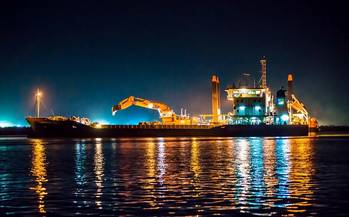U.S. Ocean and Great Lakes Economy Sees Large Growth -NOAA
Posted by Eric Haun
Monday, August 24, 2015
In 2012, U.S. ocean and Great Lakes economy grew much faster than overall GDP
The U.S. ocean economy outpaced the domestic economy between 2011
and 2012, with an increase of $22 billion in gross domestic product,
from $321 billion to $343 billion, according to a new National Oceanic
and Atmospheric Administration (NOAA) analysis.
Adjusting the figures to remove the effects of inflation, this
increase equates to a 10.5 percent rate of growth—more than four times
as fast as the U.S. economy as a whole. The report is based on 2012 U.S.
national economic statistics released in August 2014.
Five of the six ocean economy sectors grew faster than the national
average of 2.5 percent. Offshore mineral extraction, which saw
employment increases of 8.6 percent and inflation-adjusted GDP increased
by 20.9 percent, grew most dramatically of all. The study looked at
coastal marine construction, living resources, offshore mineral
extraction, ship and boat building, tourism and recreation, and marine
transportation.
NOAA’s 2012 Report on the U.S. Ocean and Great Lakes Economy shows
how dependent local businesses are on the U.S. ocean and Great Lakes.
These businesses represent an essential and resilient part of our
nation’s economy. In 2012, these sectors employed 2.9 million
people—more than crop production, telecommunication and building
construction combined—and produced more than $343 billion in goods and
services.
“The oceans and Great Lakes benefit Americans from all across the
country, no matter where they live, even if it’s not near the coast,”
said Jeffery Adkins, an economist in NOAA’s Office for Coastal
Management. “We fish from their waters, vacation along their coasts,
ship cargo on their surface, and extract oil, gas, sand and gravel from
their seafloors. By showing how the oceans and Great Lakes contribute
directly to the economy, this kind of data can help decision makers
protect these resources and use them wisely.”
According to the report, additional key coastal economic 2012 facts included:
- $113 billion in annual wages,
- 3.8 percent growth in employment, more than twice the 1.8 percent national rate,
- 147,000 total business establishments,
- 108,000 new jobs created,
- Salaries were above the national average for workers in marine construction, ship and boat building, marine transportation, and offshore mineral extraction. The national average for wages was $49,000; for the ocean and Great Lake industries, the national average ranged from $63,000 to $143,000.
In addition, the U.S. ocean and Great Lakes economy is a strong contributor to the economy of many states:
- California employed the highest number of workers, accounting for 17 percent of the nation’s ocean-dependent employment and 22 percent of the nation’s employment in the marine transportation sector.
- Texas contributed the most to the nation’s ocean GDP, mainly from offshore mineral production. Texas alone produced 35 percent of the ocean-dependent GDP in 2012.
- Michigan was the leading state in the growth of Great Lakes and ocean employment. After being severely affected by the economic downturn, Michigan’s ocean employment grew prominently by 8 percent in 2012, much faster than the overall state average of 2.1 percent.
This information was derived from NOAA’s Economics: National Ocean
Watch (ENOW) data set. ENOW provides time-series data on the ocean and
Great Lakes economy and is available for counties, states, regions, and
the nation in a wide variety of formats. These data feature nationally
consistent information that helps users understand and manage the
diverse economic demands placed on the oceans and Great Lakes.
NOAA’s Office for Coastal Management developed ENOW time-series
data and other products using information from the Bureau of Labor
Statistics, U.S. Department of Labor, and the Bureau of Economic
Analysis, a sister agency of NOAA in the U.S. Department of Commerce.
